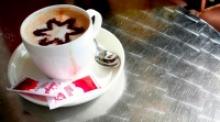I am surrounded by coffee kiosks. I customarily pass five or six coffeehouses a day, some with custom small-batch roasts, in an effort to go anywhere at all. Even the local grocery stores carry the beans produced by local roasters. The local climate is pro-coffee, to the extent that you have to hunt for the segregated tea sections in local grocery stores. Ordering coffee here is an art in and of itself, worthy of the mockery of coffee house trendiness in L. A. Story. Americano, cappuccino, mocha, expresso, latte, soy latte, half-caf, macchiato—it's complicated. Don't ask me to explain the decaf espresso crowd; I can't. My local purveyor has a menu item called "Why Bother: Sugar free, non-fat, decaf latte." I usually ask for a sixteen ounce drip coffee. The coffee there is roasted by a local roaster, and it's a special blend; sometimes I can tell it was a little late in leaving the roaster, and sometimes, it's been on the burner too long.
But it's still coffee. Coffee that has already had a traumatic cross-continental journey, for a fruit, or a "bean" that began life as a shiny bright red "cherry" on a bush. The ripe cherries need to be pulped within hours of picking, to remove the bright red flesh. The beans are then "fermented," a process which softens the fibrous outer coat after about 12 to eighteen hours so that it can be removed with water. If the cherry contains a single, and often slightly smaller berry, the resultant coffee is described as "peaberry." The de-fleshed beans are dried in the sun for three to five days. Even after drying, the beans have the papery "parchment"—shell a thin silvery outer covering, and referred to as "parchment coffee." Parchment coffee is hulled, to remove the outer skin; typically this is done by a machine. The coffee is then graded in terms of quality; pretty much every coffee-growing region has a different vocabulary for the quality stages, but the actual grades are similar. Much of it is sold as "green" or unroasted coffee at this stage. Once the coffee is roasted, what began as about 500 pounds when picked, results in about 80 pounds of roasted coffee.
I think, once I've managed to avoid the "robusta" (from a slightly bitter, more acidic species of coffee), that pretty much all coffee has its merits, ranging from the Engineering Department's "Bomb Shelter" coffee from the massive urn, coffee that dissolved styrofoam cups, to the sixteen ounce "drip" at my local, to what may be the ultimate in Really Good Coffee, Irish Coffee from San Francisco's Buena Vista Cafe. I note that as much as Washington is known for its "coffee culture," Oregon has it's own tribes of coffeehouses, and small-batch roasters, and Vancouver, Canada is equally proud of her baristas' talents.
My work is cut out for me, but I'll endeavor to drink as much coffee as my heart will tolerate. Sleep is for the weak-minded.
Image credit: C. Michael Neely
